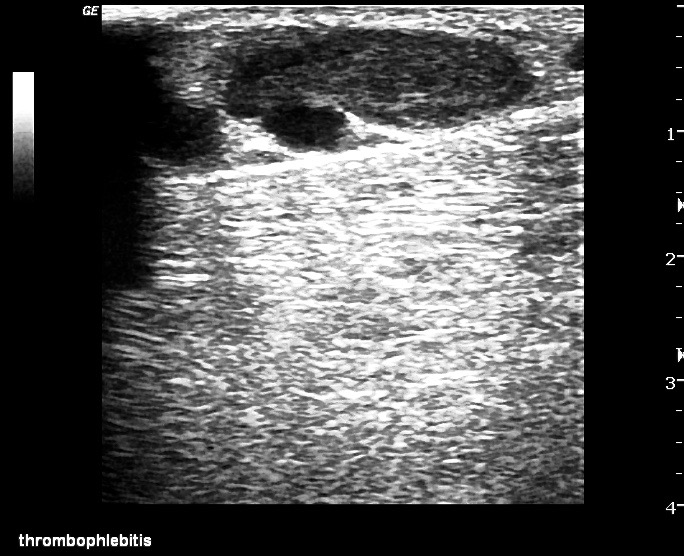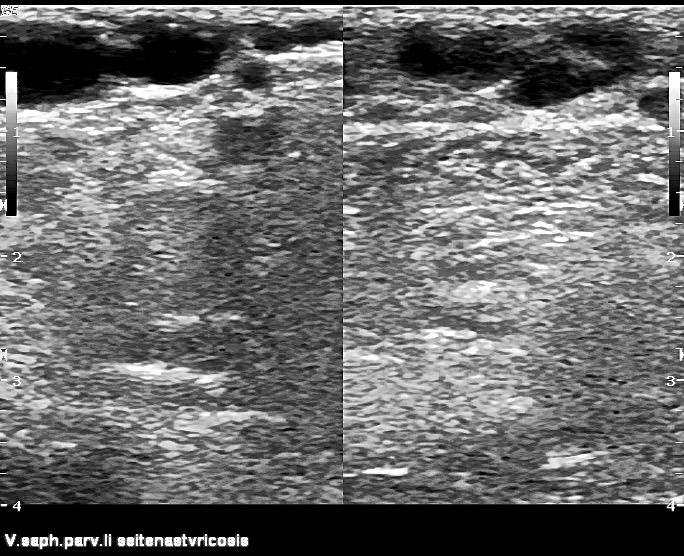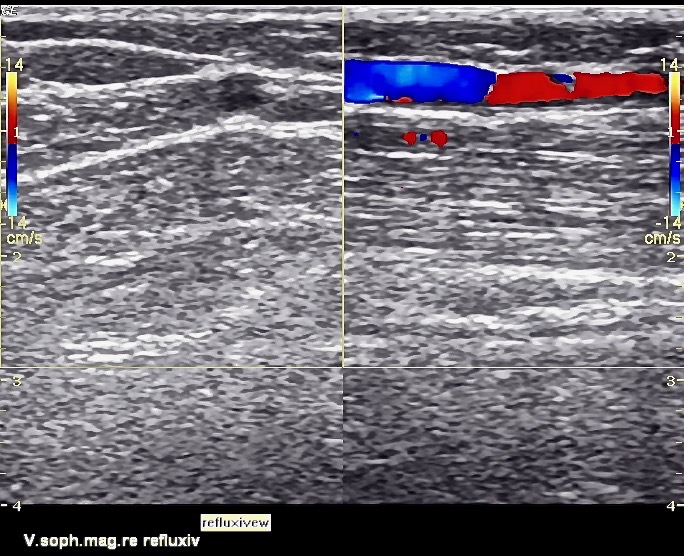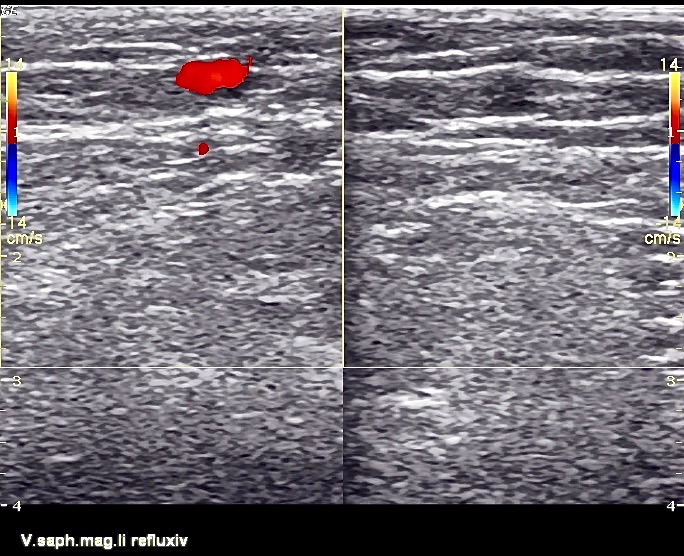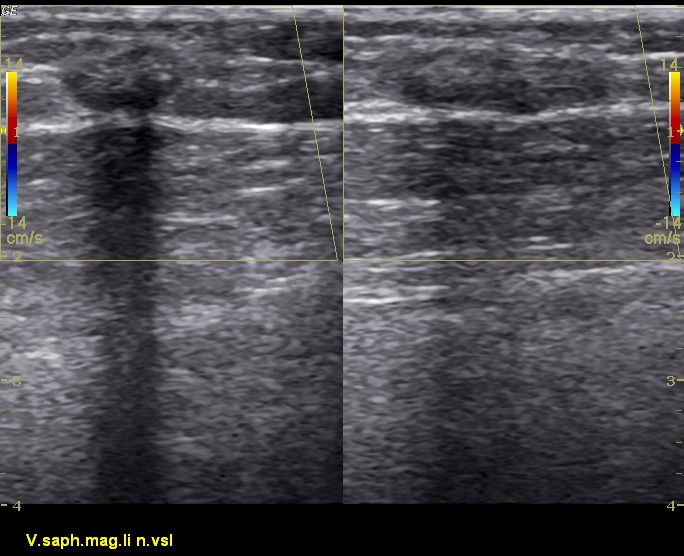New Saphenion therapy protocol for superficial vein thrombosis
Dr. Ulf Th.Zierau, PD Dr. W. Lahl
The Saphenion Therapy Protocol for Phlebitis / Thrombophlebitis / Superficial Vein Thrombosis / Skin Vein Thrombosis has been adapted based on new scientific findings and standards.
Superficial vein thrombosis (SVT) is a very common acute disease in general practitioner and venous practices. Formerly referred to as phlebitis or thrombophlebitis and treated quite differently, today the term skin vein thrombosis is favored. This clearly shows the gain in knowledge in the analysis of the supposedly slight skin vein inflammation. The analysis of the literature and recent scientific work (Schimmelpfennig, Marshall, et al.) makes it very clear that SVT is dangerous and with numerous side effects afflicted acute disease of the skin vein system.
SVT is a typical acute complication especially in the warm months of the year!
Massive SVT on the left lower leg drawn to the GSV and SSV
Saphenion Therapy Protocol SVT – Epidemiological dates
Up to 11% of the total population suffer from superficial venous thrombosis. In 17% of all women and 7% of all men, SVT is seen.
In patients with varicose veins, the incidence rises to over 50%!
Duplex ultrasonography before surgery, the truncal varicose veins are free and can be treated well with vein glue
In 15% of all cases, SVT enters the deep venous system and thus forms the starting point for deep vein thrombosis (DVT). This occurs in 25% of all cases. The risk of a pulmonary embolism is then over 30%!
The author of this news also suffered in 2008 a superficial vein thrombosis, from which a knee vein thrombosis with subsequent pulmonary embolism had developed.
Saphenion therapy protocol SVT: the diagnostics.
Basically, in addition to the clinical examination methods – the anamnesis, gaze diagnostics. and scanning – the methods of duplex ultrasound / Doppler sonography with color coding come into play. These give a very good picture of figure, extension, and veins involved (deep venous system!). And shows us quite quickly the possible treatment options. In addition to the normal laboratory values, a differentiated coagulation analysis and the search for a malignant tumor disease are indispensable.
Saphenion therapy protocol SVT: the therapy
We have adapted our therapy protocol accordingly to new findings. The existing guidelines are not sufficient in our opinion. The OVT should be treated similarly intensively and metbodisch glwertwertig for deep vein thrombosis. The main goal of the therapy is the prevention of thrombosis of the deep veins and the prevention of pulmonary embolism. In a second step, the predisposing factors – in the first place the varicose vein disease – should be treated with immediately.
In the first step, thrombosis-resolving injection therapy is initiated by means of fondaparinux (Arixtra 7.5 mg). This should – not 7 days as usual – run for 4 weeks and then be supported by thrombosis prophylaxis for another 4 – 8 weeks. Of course, this medication is dependent on weekly clinical and sonographic examinations. In addition, an acute ethanol cooling bandage with compression therapy with customized compression stockings and full mobilization is recommended.
In addition to the drug therapy that has just begun, Saphenion is treating always with catheter-assisted thrombus suction (aspiration thrombectomy). In the radical surgery age, the thrombus material was squeezed out here by skin incisions with a scalpel.
For more extensive findings, we also perform outpatient or day clinic duplex sonographically controlled local thrombolysis (drug dissolution) of OVT.
Saphenion therapy protocol: treatment of the varicose venous system
Due to the high incidence of SVT in patients with varicose veins, the extensive varicose vein thrombosis is in urgent need of remediation of the existing varicose veins even in summer. Today, we only use catheter systems (venous adhesive, radio wave, sealing foam). Radical surgery or emergency surgery is justified only in proven pelvic vein thrombosis.
Endovenous catheter therapy of the truncal varicose veins by means of vein glue 6 weeks after the therapy of an SVT left lower leg.
In our experience, the immediate rehabilitation of the varicose truncal veins is also necessary because of form in the healing process of the superficial skin vein thrombosis in the interior of the vein scar strands that can complicate a catheter therapy or even a radical stripping after a long time considerably.
Links /Referenzen:
Aktuelle Standards der Diagnostik und Therapie der oberflächlichen Venenentzündung: J. Schimmelpfennig1, C. Schwahn-Schreiber2, M. Marshall31 Burgebrach, 2 Otterndorf, 3 Tegernsee/Planegg, vasomed 25. Jahrgang_3_2013 151
Guyatt GH et al. Executive Summary : Antithrombotic therapy and prevention of thrombosis, 9th ed: American College of Chest Physicians Evidence-Based Clinical Practice Guidelines CHEST 2012; 141 (suppl 2): 7S-47S
https://www.ncbi.nlm.nih.gov/pubmed/31031497
https://www.ncbi.nlm.nih.gov/pubmed/30970086
https://www.ncbi.nlm.nih.gov/pubmed/30899292
https://www.ncbi.nlm.nih.gov/pubmed/29637225
https://www.ncbi.nlm.nih.gov/pubmed/28116936
https://www.ncbi.nlm.nih.gov/pubmed/25252552
https://www.ncbi.nlm.nih.gov/pubmed/24891243
https://www.ncbi.nlm.nih.gov/pubmed/24448056
Bildernachweis:
Newsbild: The old doctor- Puschkin Museum Moskau
Duplexbefunde: Saphenion

